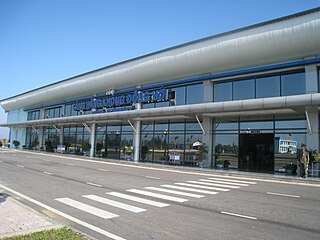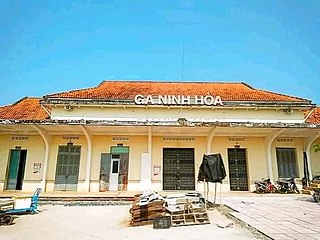
Vinh International Airport is located in Vinh city of Nghệ An province in northern Vietnam. It is a mixed military/civil airport. It used to be one of the two major military airbases in Vietnam, along with Gia Lam Airbase in Hanoi.

Dong Hoi Airport is an airport located in Loc Ninh commune, 6 km (3.7 mi) north of Đồng Hới city, capital of Quảng Bình Province, in North Central Coast of Vietnam, about 500 km (310 mi) southeast of Hanoi by road. The facilities cover 173 ha, on a sandy area, by the coast of South China Sea. The runway approaches near the seashore and nearly parallel to the Highway 1. The airport, like all civil airports in Vietnam, is owned and operated by Airports Corporation of Vietnam.

The V.League 1, also called LPBank V.League 1 for sponsorship reasons, is the top professional football league in Vietnam, controlled by the Vietnam Professional Football Joint Stock Company (VPF). It is contested by 14 clubs who play each other on a home and away basis. The team finishing at the top at the end of the season is crowned the champion and enters the AFC Champions League Two.

Cầu Giấy is an urban district of Hanoi, the capital city of Vietnam. It is located roughly to the west of urban Hanoi. Cầu Giấy has a unique urban landscape, with new urban developments interlacing old historical artisan villages. The most well-known of them is a cluster of Dịch Vọng villages with its popular cốm dessert.
Miss Universe Vietnam is a national beauty pageant in Vietnam to select the country's representative to the Miss Universe, one of the Big Four major international beauty pageants. Along with Miss Vietnam and Miss World Vietnam, Miss Universe Vietnam is one of the Big Three national beauty pageants.

Vietnam Electricity is the national and the sole public power company in Vietnam. It was established by the government of Vietnam as a state-owned company in 1994, and has operated officially as a one-member limited liability company since 2010.
The 2012 V-League season was the 29th season of Vietnam's national football league and the 12th as a professional league. The season started on 31 December 2011 and finished on 19 August 2012. On 15 December it was announced that the league would change name and would simply be known as the Premier League. Then, it was changed name to Super League.

Vũ Văn Thanh is a Vietnamese professional footballer who plays as a right-back for V.League 1 club Công An Hà Nội and the Vietnam national team.

Trần Đình Khương is a Vietnamese professional footballer who plays as a defensive midfielder or a centre back for V.League 1 club Becamex Bình Dương and the Vietnam national team.

The 2018 National Cup is the 26th edition of the Vietnamese National Cup, the football knockout competition of Vietnam organized by the Vietnam Football Federation.

Cát Linh Station is a metro station in Hanoi, located in Đống Đa, Hanoi.

The National Assembly Building of Vietnam, officially the National Assembly House and also known as the New Ba Đình Hall, is a public building located on Ba Đình Square across from the Ho Chi Minh Mausoleum in Hanoi, Vietnam. Construction started on October 12, 2009, and finished on October 20, 2014. The building is used by the National Assembly of Vietnam for its sessions and other official functions.
Tô Văn Vũ is a Vietnamese professional footballer who plays as a right winger or right-back for V.League 1 club Thép Xanh Nam Định.

Hồ Thanh Minh is a Vietnamese professional footballer who plays as a forward for V.League 1 club Hà Nội.

Ninh Hòa station is a railway station on North–South railway. It is located in Ninh Hòa, Khánh Hòa province, Vietnam.
Thủ Đức Station is a future elevated Ho Chi Minh City Metro station on Line 1. Located in Bình Thọ Ward, Thu Duc, Ho Chi Minh City, the station is planned to open in 2024.



























